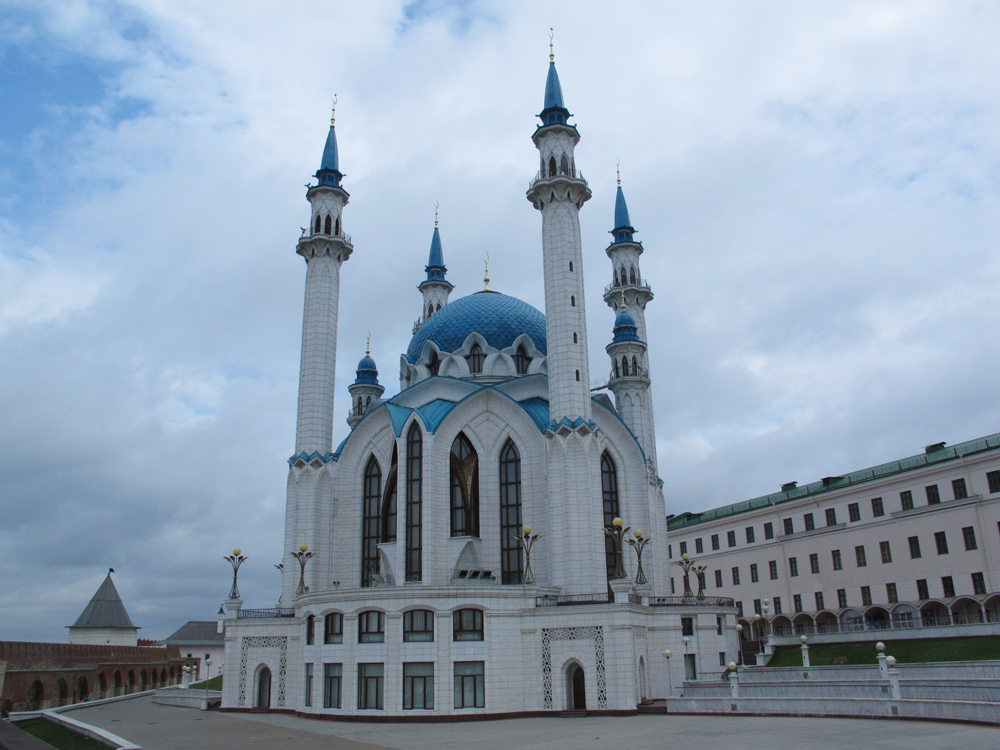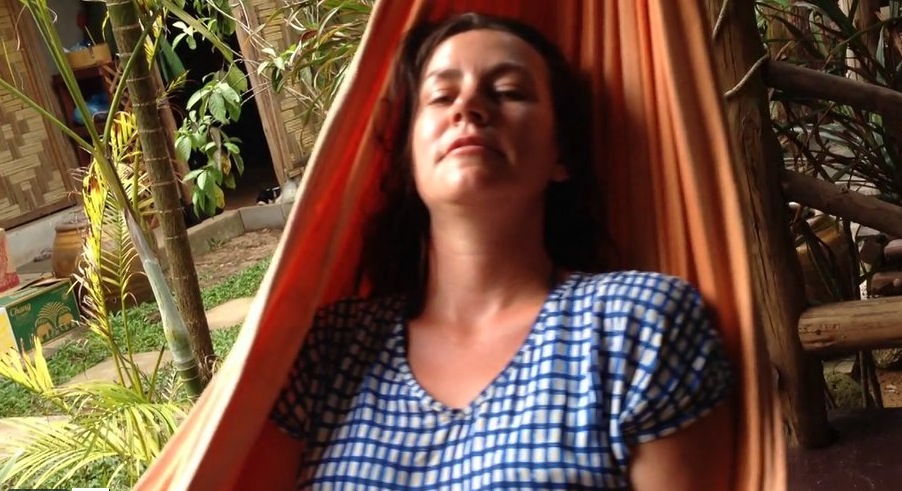Welcome to Mongolia, the land of vast empty, hilly landscapes with barely any people… It was the first time we discovered that what might work for majority travelers, and by work I mean most loved it, will not work for us.
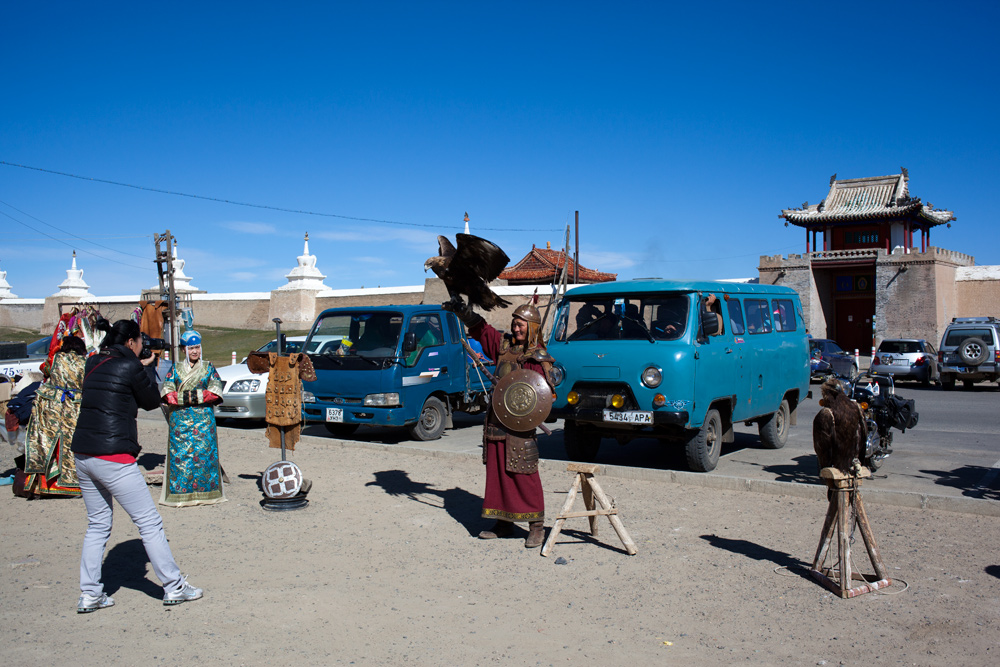 Picture time outside of the temple walls in ancient capital of Karakorum, Mongolia.
Picture time outside of the temple walls in ancient capital of Karakorum, Mongolia.
Let me give you a brief background, to put things in proper context.
Initially, I wanted to check out Mongolia, however, reviews we got from a couple of our friends were less than flattering. The general summary was that some speak Russian, you should get out of Ulan-Bator as soon as you can, and be prepared to drive for long stretches of the time.
Getting to Ulan-Bator
 Our lone train car that took us from Naushki, Russia to Sukhbatar, Mongolia.
Our lone train car that took us from Naushki, Russia to Sukhbatar, Mongolia.
We left Moscow on September 1st to traverse Russia via train. The total journey, after stopping in Nizhny Novgorod, Kazan, Yekaterinburg, Krasnoyarsk, the island of Olkhon, and Ulan-Ude, took us 13 days. The pace was fast and we covered a lot of ground. Our first major delay on the road was in the border village Naushki, where you will find absolutely nothing… No, really, there is nothing there, we tried while we had to wait 5 hours for our train car to be hooked up to the Mongolia train.
We have also met a cool Spaniard who was traveling across Russia by himself, as well as a Japanese traveler, who was bewildered by the mysteries of Russian bureaucracy. See, in Russia, if you buy an international train ticket in Moscow, you can only return it in Moscow, should your travel plans change. Yet if you are in a different location, well, too bad. I’ve tried to help him the best I could, since the counter ladies were not helpful, and he spoke no Russian at all.
Anyway, after 4 hours of lingering around the train station and clinging to the faint wifi signal, we boarded our unhooked train car for the final passport check and inspection. Waited few more hours, chatted with a customs officer for a bit about life, things, and everything and were on our way to the mysteries steppes of Mongolia.
Our first stop was at the town called Sükhbaatar, translates as red hero and named after the Mongolian revolutionary leader, where we had to spend another few hours waiting. Initial encounter with Mongolia was great, the customs ladies who took our passports look professional and very made up, spoke English and Russian. Soon after we got our documents back, the train car was flooded with people trying to exchange money offering a variety of rates, ranging from 1400 to 1600 tugriks for 1 dollar. Mind you, the official rate is 1700, but we forgot to check what it was before the arrival. We cleverly thought to take out money from the ATM at the station, since bank rates usually better, only to discover that all the cash was taken out by same people who tried to exchange money inside the train. Conveniently, they were waiting right by ATMs, saying see, we told you to exchange with us.
Our second encounter was even less pleasant as we ventured out to the town, with our Spanish friend, to see what the prices are for food, snacks and beer. We found that the only proven way to gauge the prices is to pick one item available throughout the country and use it as a base. For example, in China, Snickers bar fluctuated between 5 yuan to 20 yuan, depending on your location. Anyway, we got harassed by a drunk outside the store, who grabbed Chema, our Spanish friend, by the jacket and attempted to kick him making gestures to give up our money. You simply cannot be aggressive when engaging in conflict in a new country in the dark, since you will always be at fault in the eyes of locals. We brushed him off and quickly made our way back to the station. Welcome to Mongolia, we thought.
Eventually our train came and we were on the way to Ulan-Bator.
Arrival and Steppe
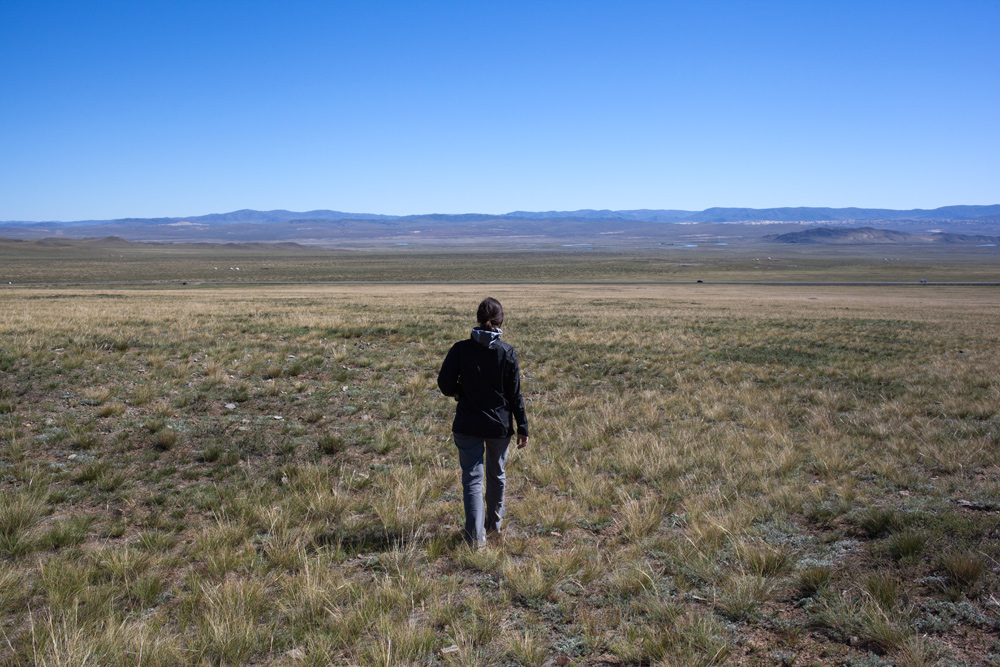 The big open steppe, somewhere between Ulan Bator and Karakorum, Mongolia.
The big open steppe, somewhere between Ulan Bator and Karakorum, Mongolia.
We got in early, around 6 am to a semi-chaotic train station and after wandering back and forth we met up with our guide, who was supposed to take us out into steppe for the next few days.
First order of business, getting train tickets to Beijing, as train leaves every five days and if you miss the next one, you have to linger around Ulan-Bator. We were taken to a train ticket office, which was closed – too early. We had no cash, and odds that the train ticket office takes cards were slim, so after trying four ATMs we finally succeeded in taking out tugriks, wads of them.
Back to the train office, still closed. The temperatures were freezing and we waited in a black Prius with our guide and a driver for the next 30 minutes for it to open only to find out that there are no tickets… What to do? After some back and forth in Mongolian between our guide and the ticket lady, boom, tickets appear in 8 days but in separate coupes. Purchased!
Got breakfast, took some notes on the upcoming adventure, and went to the grocery store to get candy, water, and snacks for the steppe. Candy was for the kids and families, water and snacks for us. Next surprise, our guide is not coming with us and instead we get another driver, who was supposed to speak some English and take into the country, as he is familiar with surroundings.
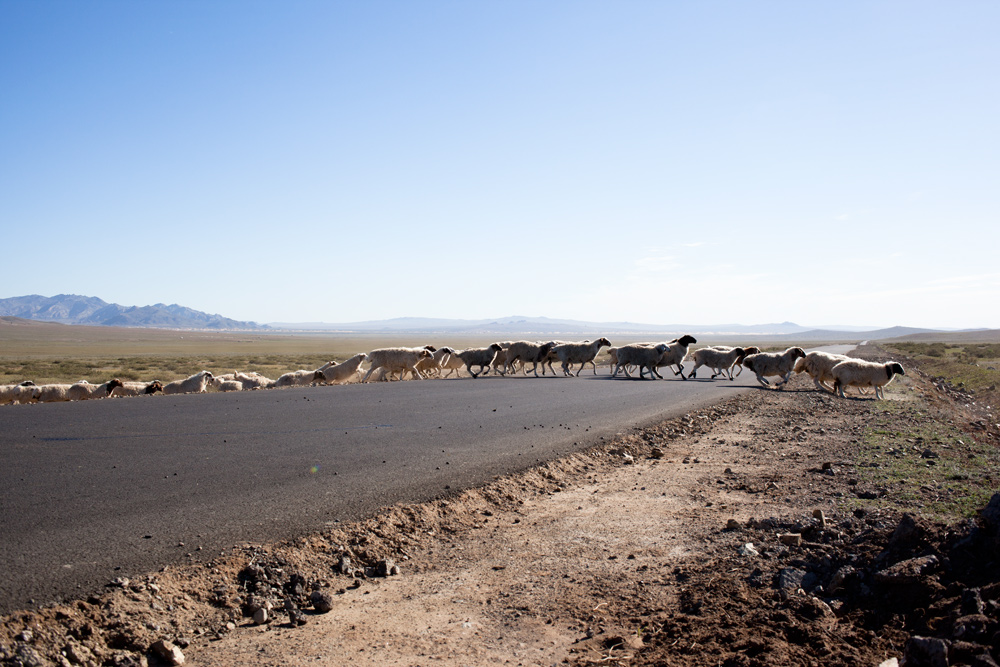
Driving was punctuated with lots of stops to allow various animals to pass through the road.
And we were on our way to discover our discouraging reality – our driver, we are still in the black Prius that picked us up from the train, does not speak English at all. In fact, he does not even speak Russian, except for several words: tourists, look, sleep, eat, go, stop, good. Very useful lexicon for a guide that is supposed to tell you about the country. He also has little idea where we are going, so we point out Karakorum, ancient Mongolian capital as our destination. We find ourselves in a foreign country with no way to communicate, being taken into steppe by a stranger, how fun!
If we were to think of only one word to describe our three days in Mongolian countryside, it would be driving. We have since met several people who went on different tours, and they too, confirmed that most days its all about the driving – 6 hours, 8 hours, up and down the bumpy roads.
Anyway, three or four hours later we arrive to a small town, 450 km west of Ulan-Bator, which turns out to be Karakorum, and locate a yurt camp – 8 yurts set up next to each other with a giant yurt next door for meals. By now, we are tired from the trip and our “guide” and want to get some space and rest, beers and a meal.
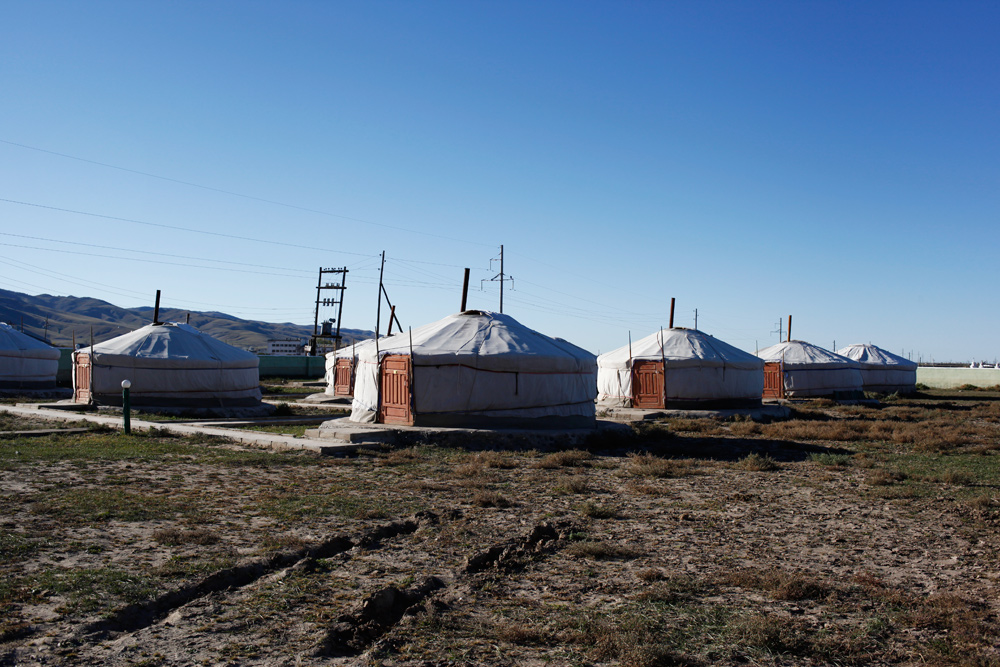

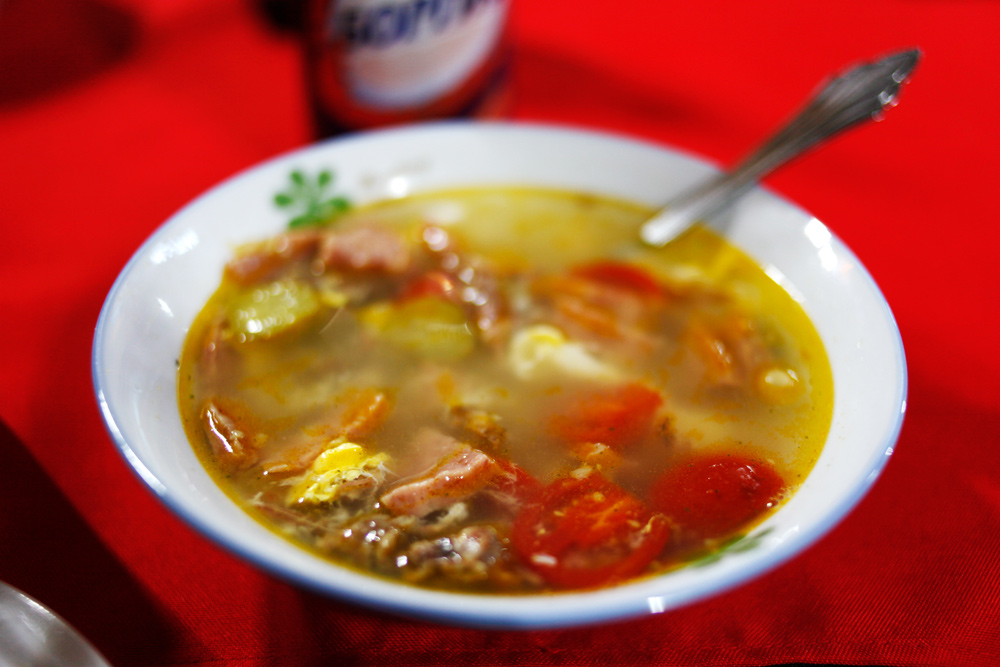

 Lodging and meals at our ger camp in Karakorum, Mongolia.
Lodging and meals at our ger camp in Karakorum, Mongolia.
We spent two nights in a ger – a traditional tent like building where the Mongolian nomads live. During our excursion we visited two different families out in the steppe, and remarkably their gers looked quite similar to ours, with just a bit more furniture ( a cabinet for kitchen wares and another for clothes and household things) and fewer beds. Poor Sergey had to get up in the night though to tend to the fire, so he probably had a less enjoyable experience than me.
Next day was uneventful, we checked out monastery nearby, and went to a museum, which is basically all you can do in Karakorum. Oh yea, you can also go see a stone carving of a penis and a vagina, on a hill, as a relic of old city…
Another day, same steppe. We went to see wild horses and stopped by a few families on the way. The cool bit about visiting with nomads is the fermented horse milk – its just a tad alcoholic, which breaks up the awkardness – hi, we are westerners coming here to see how you live, ah well, we can’t communicate? Ok well see you later, more like never.
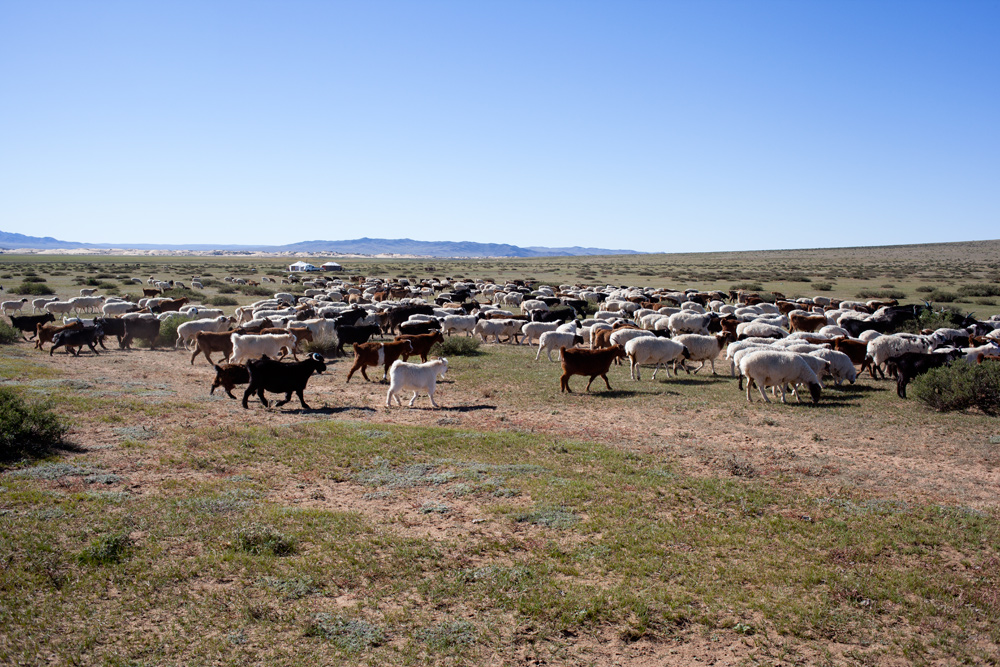 Mongolians say they are the people of five animals – sheep, goat, cow, horse, and camel. They aren’t kidding –these five are everywhere in staggering numbers.
Mongolians say they are the people of five animals – sheep, goat, cow, horse, and camel. They aren’t kidding –these five are everywhere in staggering numbers.
After lots more of vast empty space, we’ve had enough and decided to cut our steppe adventure short and head back to the capital, back to the city lights.
Final Thoughts
As we traveled further, we met many people who really loved Mongolia. They loved it because it is untouched by development, a place where people still live the way they lived centuries ago. They loved the beautiful vast lands of hills and valleys. They loved Gobi desert. They just loved it.
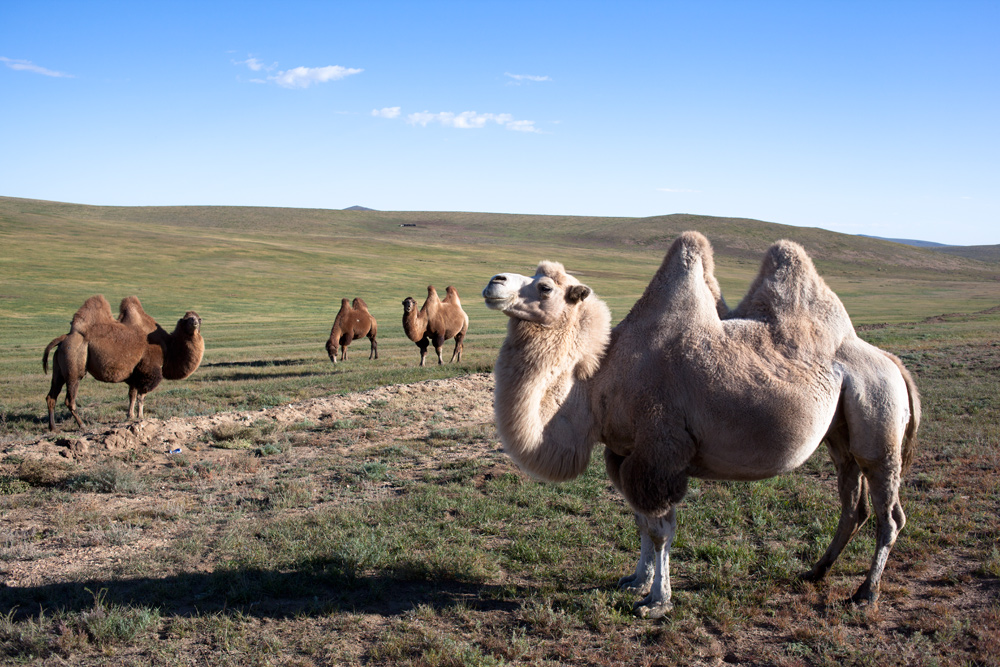 Camels grazing on the grass by the side of the road. Common sight even outside of the actual desert in Mongolia.
Camels grazing on the grass by the side of the road. Common sight even outside of the actual desert in Mongolia.
We, however, did not love it. We appreciated the experience and beauty of the steppe, but it is not for us. If you are looking to go off the grid and drive for hours and hours to stay with a local family, perhaps, Mongolia is perfect for you. In fact, you should go and see it for yourself, but one time is plenty for our taste.
Note the contrast in our spirits between four o’clock video in steppe, above, and when we are back in the city, below. See Ulan-Bator post for a detail account of the city.

